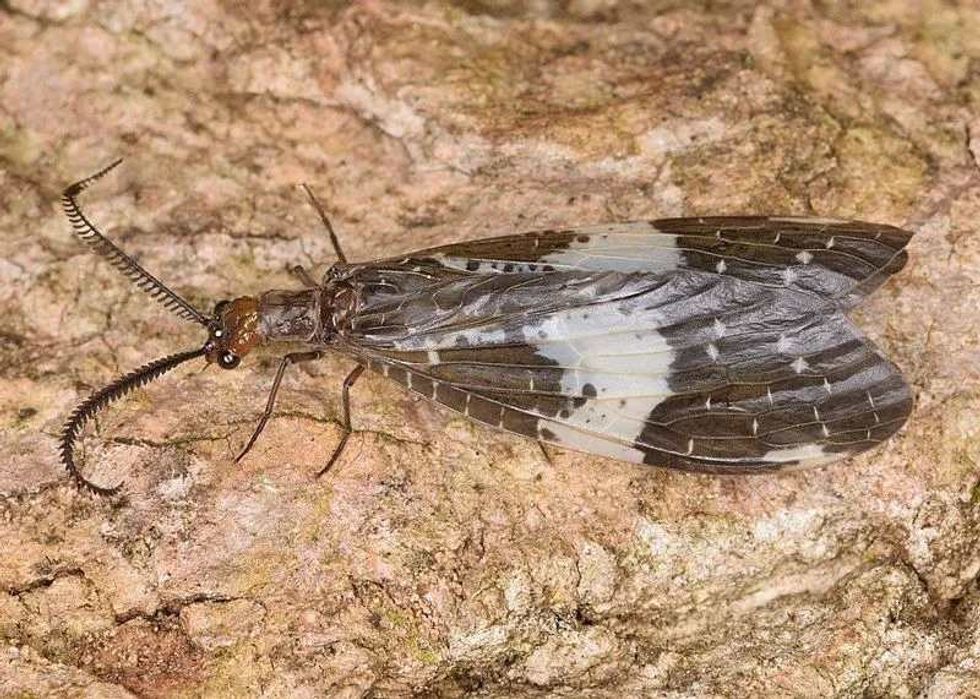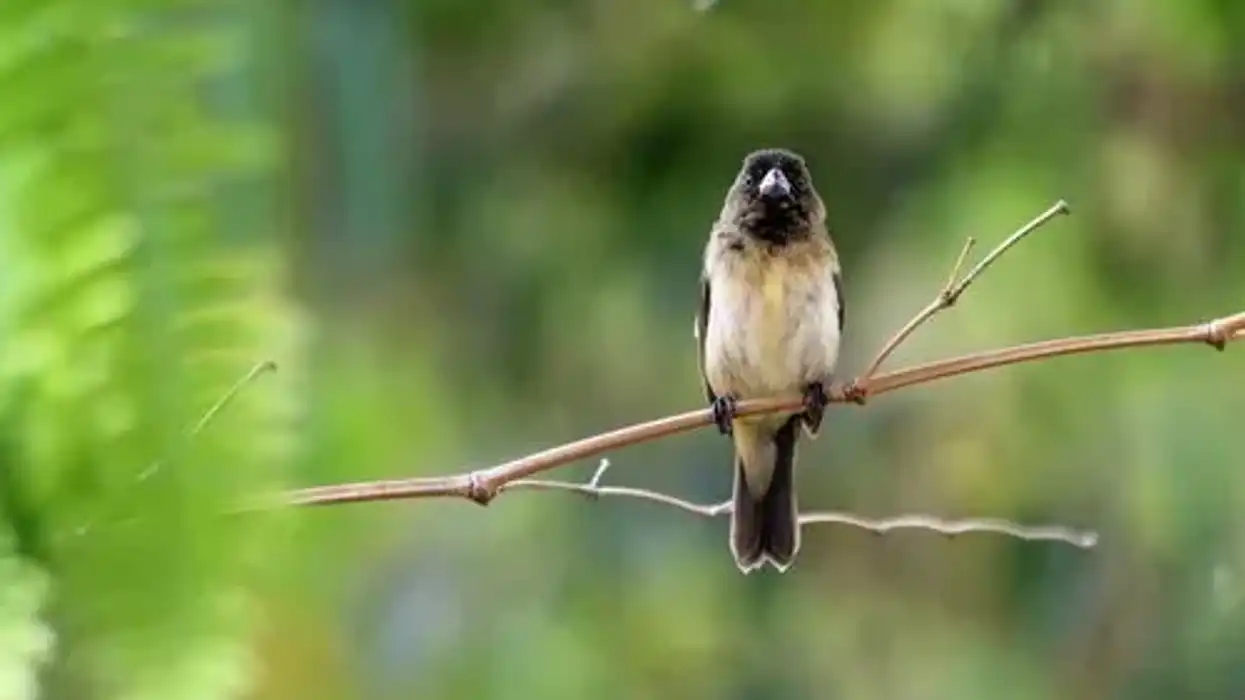Fishflies are flies found mostly in North America. The scientific name of a fishfly is Chauliodes rastricornis with 'chauliodes', meaning 'remarkable tooth' and 'rasticornus', meaning 'rake-horned'. Another scientific name for them is Chauliodes pectinicornis.
This species of fly has a large body and long wings. Summer fishflies are a common species in North America with an interesting life cycle.
The antennae of male flies are larger and more feathery compared to females. They also have teeth that look like a comb. Fishflies can pinch which can be painful but does not cause long-term problems, and so they are considered to be harmless.
Female dobsonflies and fishflies look very similar. Male dobsonflies have large pincers while fishflies do not. Adult fishflies are normally found in vegetation that lines streams to be near food that their larvae need to survive.
They are often drawn to various lights at night. Adult fishflies don't live for long and die shortly after laying eggs. Different marine environments are used by various species.
The majority of a fishfly's life is spent in the water, developing through juvenile stages with only a short period, often less than a week, spent as a winged adult. This life cycle is similar to many other insects with aquatic larvae.
Females lay their fertilized eggs on plants or trees that hang over the water and the larvae immediately jump into the water after hatching.
They will survive as aquatic larvae for many years as they feed, mature, and molt. They migrate from the stream to pupate in a protected location, which may be in the dirt, decaying wood, or even behind loose bark.
A few scientists claim that fishflies and mayflies are the same, however it is largely considered that they are two different species of flies. You can tell these two flies apart by their appearance. An adult fishfly is larger and has a different shaped body compared to a mayfly.
If you like reading about animals, do check out our articles on red paper wasp and botfly.
Fishfly Interesting Facts
What type of animal is a fishfly?
Fishflies are large insects with long antennae. They belong to the family Corydalidae and order Megaloptera.
What class of animal does a fishfly belong to?
Fishflies belong to the class of Insecta. They are a part of the dobsonfly and alderfly group of insects.
How many fishflies are there in the world?
The exact number of fishflies in the world is not known.
Where does a fishfly live?
A fishfly is found in North America where there are about 18 species of the family.
What is a fishfly's habitat?
A fishfly is generally found near water bodies such as streams, rivers, and ponds. This is because their larvae require an aquatic habitat. They are mostly found in eastern North America. A summer fishfly can also be found around wet areas.
Who do fishflies live with?
Fishflies live in large groups of their own species. Their eggs are also laid near water bodies in a huge number. The larvae crawl to the water body as soon as they are hatched and spend most of their time underwater.
How long does a fishfly live?
A fishfly can live up to seven days as an adult. However, their entire lifespan lasts for several years but most of this time is spent in the larvae stage.
How do they reproduce?
Female fishflies lay eggs on top of a water body. As soon as the eggs hatch, they move to the water in search of food. The larvae stage goes on for several years and fishflies spend most of their time underwater. In comparison, adults lay on the ground and eat worms and beetles from the water body.
What is their conservation status?
The conservation status of fishflies is Not Listed in The International Union for Conservation of Nature Red List of Threatened Species (IUCN Red List), so it can be assumed that there is no immediate harm to its population.
Fishfly Fun Facts
What do fishflies look like?
Fishflies are usually gray or rusty colored insects and their wings are either clear or very light in color. They have two pairs of wings which both extend towards the end of their bodies. The length of their wings is around 3 in (7.6 cm). Their antennae are the most recognizable characteristic of these flies. The long, feathery antenna makes it different from other flies.
How cute are they?
This species of insects is not cute to look at. The antennae and size often scare people who consider them to be harmful.
How do they communicate?
Although not much is known about their communication process, fishflies often use their jaws or mandibles to fight. Therefore, it can be understood that they use their body to communicate.
How big is a fishfly?
A fishfly is 1-2 in (2.5-5 cm) in length, however, its wingspan is about 3 in (7.6 cm). It is about double the size of an average honey bee.
How fast can a fishfly fly?
Since fishflies spend most of their time in the water, the speed at which they can fly is not known.
How much does a fishfly weigh?
The exact weight of fishflies is not known.
What are their male and female names of the species?
Fishflies do not have separate names for males and females. However, they have about 15 genera, some of which are called Anachauliodes, Neochauliodes, Ctenochauliodes, and Parachauliodes.
What would you call a baby fishfly?
A baby fishfly is called a 'fishfly larva'. These larvae spend most of their time inside water.
What do they eat?
Adult fishflies eat dragonflies, larvae of water beetles, clams, mussels, and algae. In contrast, hellgrammites (larvae) prefer decomposing animal and plant matters.
Are they dangerous?
Fishflies can pinch you with their mandibles but are otherwise harmless to humans.
Would they make a good pet?
No, this species of fly depends on their natural habitat and they live in groups of their own kind.
Did you know...
Ctenochauliodes is one the of the genera of fishfly. It is one of the few species of insects that is completely cosmopolitan. Females of this genera are slightly bigger than males.
Their reproduction process is also slightly different as females fertilize eggs internally. Cat fleas are solitary creatures. A Ctenocephalides felis, in its adult state, spends much of its time in the host's sleeping area, only hopping onto it when it has to eat.
The flying season for adult flies typically starts during spring.
A fishfly larva is used as a natural bait for fish.
Adult dobsonflies and fishflies are difficult to find because they are only around for a few weeks every year.
What is the purpose of fishflies?
The presence of fishfly larvae in streams means that the aquatic health of that water body is good. They are considered to indicate whether streams are healthy because they cannot survive in polluted water. Dobsonflies and fishflies are similar in their lifestyle.
How do fishflies compare with similar flies?
Dobsonflies and fishflies are similar to look at. However, dobsonflies are slightly larger than fishflies. This is one of the primary reasons why people often confuse the two. Both these species (dobsonflies and fishflies) undergo complete metamorphosis.
Here at Kidadl, we have carefully created lots of interesting family-friendly animal facts for everyone to discover! Learn more about some other arthropods including puss moth, or mayfly.
You can even occupy yourself at home by drawing one on our house fly coloring pages.










